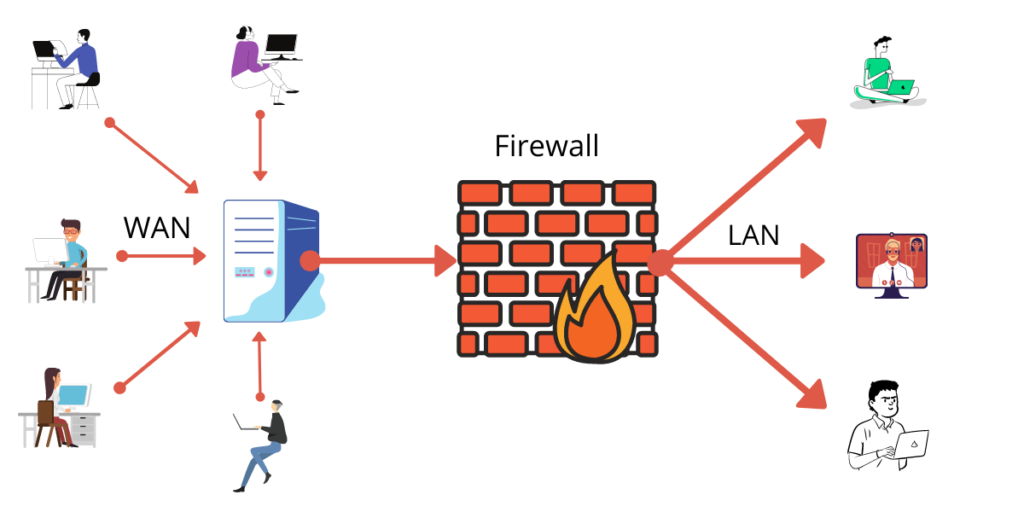Firewalls are essential components of network security that act as barriers between trusted internal networks and untrusted external networks, such as the internet. They serve as the first line of defense against cyber threats and unauthorized access. This comprehensive note explores various firewall techniques and best practices for safeguarding your network.
1. Packet Filtering Firewall:
- Overview: Packet filtering firewalls examine data packets’ header information, including source and destination IP addresses, port numbers, and protocols.
- Functionality: Rules are defined to permit or deny packets based on specific criteria.
- Use Cases: Basic network security, ideal for simple network configurations.
2. Stateful Inspection Firewall:
- Overview: Stateful inspection, or dynamic packet filtering, tracks the state of active connections, allowing it to make more intelligent decisions.
- Functionality: It evaluates the state of connections and permits or denies traffic based on the connection’s state.
- Use Cases: Provides improved security compared to packet filtering, suitable for most network setups.
3. Proxy Firewalls:
- Overview: Proxy servers act as intermediaries between internal clients and external servers, adding an extra layer of security.
- Functionality: They cache and forward requests, hiding internal network details and offering content filtering and access control.
- Use Cases: Enhanced security and privacy, often used in corporate environments.
4. Deep Packet Inspection (DPI):
- Overview: DPI firewalls analyze packet contents, not just headers, enabling them to inspect and block specific application protocols and detect malicious content.
- Functionality: It examines the data within packets, making it effective against advanced threats.
- Use Cases: Advanced threat protection, recommended for comprehensive security.
5. Next-Generation Firewalls (NGFWs):
- Overview: NGFWs combine traditional firewall features with advanced capabilities like application awareness, intrusion prevention, and antivirus filtering.
- Functionality: Offers holistic protection against modern threats by incorporating multiple security layers.
- Use Cases: Ideal for enterprises and organizations with complex security needs.
6. Intrusion Detection and Prevention Systems (IDPS):
- Overview: IDPS solutions monitor network traffic for suspicious activities or known attack patterns.
- Functionality: They can complement firewalls by providing real-time threat detection and prevention.
- Use Cases: Enhances security by identifying and mitigating threats proactively.
7. Application Layer Filtering:
- Overview: Filters traffic based on specific applications or services, allowing precise control over what is permitted or blocked.
- Functionality: Useful for managing access to applications like social media or streaming services.
- Use Cases: Fine-grained control over network access and usage.
8. Virtual Private Networks (VPNs):
- Overview: VPNs create encrypted tunnels over untrusted networks, securing data in transit.
- Functionality: Used in conjunction with firewalls to protect remote access and site-to-site connections.
- Use Cases: Essential for secure remote work and connecting geographically distant offices.
9. Security Policies and Rule Management:
- Overview: Effective firewall management entails defining and regularly reviewing security policies and rules.
- Functionality: Policies should be specific, updated regularly, and follow the principle of least privilege.
- Use Cases: Ensures that firewalls align with security goals and adapt to evolving threats.
10. Logging and Monitoring:
- Overview: Firewall logs provide crucial information for detecting and investigating security incidents.
- Functionality: Regularly analyzing logs helps identify potential threats and improve security configurations.
- Use Cases: Critical for incident response and ongoing security monitoring.
11. High Availability and Redundancy:
- Overview: Deploying redundant firewalls ensures continuous network protection, even in the event of hardware or software failures.
- Functionality: Maintains network availability and resilience.
- Use Cases: Essential for mission-critical environments.
12. User Authentication and Access Control:
- Overview: Implement user authentication mechanisms to control network access and resource permissions.
- Functionality: Ensures only authorized users can access specific resources.
- Use Cases: Improves security by limiting access to sensitive data.
13. Regular Updates and Patch Management:
- Overview: Keeping firewall firmware and software up-to-date is essential to patch vulnerabilities and maintain optimal security.
- Functionality: Ensures the firewall is protected against known exploits.
- Use Cases: Critical for minimizing security risks.
14. Security Awareness and Training:
- Overview: Educate employees and users about security best practices to reduce the risk of social engineering attacks.
- Functionality: Promotes a security-conscious culture within the organization.
- Use Cases: Mitigates the human factor in security breaches.
15. Penetration Testing and Vulnerability Scanning:
- Overview: Regularly test firewall effectiveness through penetration testing and scan for vulnerabilities that attackers may exploit.
- Functionality: Identifies weaknesses in the firewall’s configuration and defenses.
- Use Cases: Ensures the firewall remains resilient to evolving threats.
16. Adaptive Security:
- Overview: Implement adaptive security measures that can dynamically adjust firewall rules and settings based on emerging threats and network conditions.
- Functionality: Enhances the firewall’s ability to respond to evolving threats in real-time.
- Use Cases: Improves proactive threat mitigation.
17. Cloud-Based Firewalls:
- Overview: For cloud-based resources, consider using cloud firewall services provided by cloud providers to protect virtual networks and applications.
- Functionality: Offers security for cloud-based assets and complements on-premises firewalls.
- Use Cases: Essential for cloud-centric architectures.
Firewall techniques play a vital role in safeguarding networks and data from a diverse range of threats. Choosing the right firewall technique depends on the specific security requirements, network complexity, and the evolving threat landscape. A well-planned and executed firewall strategy is a fundamental component of a robust cybersecurity posture.
